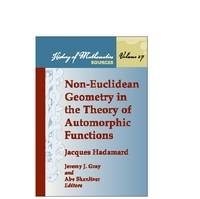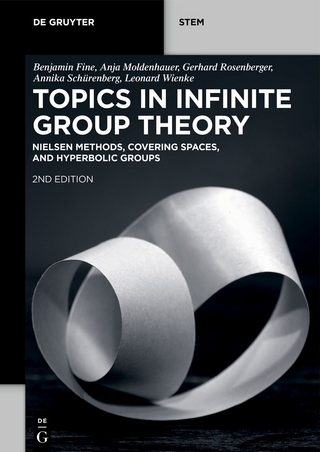
Non-euclidean Geometry in the Theory of Automorphic Functions
1999
American Mathematical Society (Verlag)
978-0-8218-2030-8 (ISBN)
American Mathematical Society (Verlag)
978-0-8218-2030-8 (ISBN)
- Keine Verlagsinformationen verfügbar
- Artikel merken
Poincare's creation of a theory of automorphic functions in the early 1880s was one of the most significant mathematical achievements of the 19th century. Part of the ""History of Mathematics"" series, this exposition offers an introduction to the subject of automorphic functions and illuminates its connection to differential equations.
This is the English translation of a volume originally published only in Russian and now out of print. The book was written by Jacques Hadamard on the work of Poincare. Poincare's creation of a theory of automorphic functions in the early 1880s was one of the most significant mathematical achievements of the nineteenth century. It directly inspired the uniformization theorem, led to a class of functions adequate to solve all linear ordinary differential equations, and focused attention on a large new class of discrete groups. It was the first significant application of non-Euclidean geometry. The implications of these discoveries continue to be important to this day in numerous different areas of mathematics. Hadamard begins with hyperbolic geometry, which he compares with plane and spherical geometry. He discusses the corresponding isometry groups, introduces the idea of discrete subgroups, and shows that the corresponding quotient spaces are manifolds.In Chapter 2 he presents the appropriate automorphic functions, in particular, Fuchsian functions. He shows how to represent Fuchsian functions as quotients, and how Fuchsian functions invariant under the same group are related, and indicates how these functions can be used to solve differential equations. Chapter 4 is devoted to the outlines of the more complicated Kleinian case. Chapter 5 discusses algebraic functions and linear algebraic differential equations, and the last chapter sketches the theory of Fuchsian groups and geodesics. This unique exposition by Hadamard offers a fascinating and intuitive introduction to the subject of automorphic functions and illuminates its connection to differential equations, a connection not often found in other texts. This volume is one of an informal sequence of works within the ""History of Mathematics"" series. Volumes in this subset, ""Sources"", are classical mathematical works that served as cornerstones for modern mathematical thought.
This is the English translation of a volume originally published only in Russian and now out of print. The book was written by Jacques Hadamard on the work of Poincare. Poincare's creation of a theory of automorphic functions in the early 1880s was one of the most significant mathematical achievements of the nineteenth century. It directly inspired the uniformization theorem, led to a class of functions adequate to solve all linear ordinary differential equations, and focused attention on a large new class of discrete groups. It was the first significant application of non-Euclidean geometry. The implications of these discoveries continue to be important to this day in numerous different areas of mathematics. Hadamard begins with hyperbolic geometry, which he compares with plane and spherical geometry. He discusses the corresponding isometry groups, introduces the idea of discrete subgroups, and shows that the corresponding quotient spaces are manifolds.In Chapter 2 he presents the appropriate automorphic functions, in particular, Fuchsian functions. He shows how to represent Fuchsian functions as quotients, and how Fuchsian functions invariant under the same group are related, and indicates how these functions can be used to solve differential equations. Chapter 4 is devoted to the outlines of the more complicated Kleinian case. Chapter 5 discusses algebraic functions and linear algebraic differential equations, and the last chapter sketches the theory of Fuchsian groups and geodesics. This unique exposition by Hadamard offers a fascinating and intuitive introduction to the subject of automorphic functions and illuminates its connection to differential equations, a connection not often found in other texts. This volume is one of an informal sequence of works within the ""History of Mathematics"" series. Volumes in this subset, ""Sources"", are classical mathematical works that served as cornerstones for modern mathematical thought.
Historical introduction A brief history of automorphic function theory, 1880-1930 The group of motions of the hyperbolic plane and its properly discontinuous subgroups Discontinuous groups in three geometries. Fuchsian functions Fuchsian functions Kleinian groups and functions Algebraic functions and linear algebraic differential equations Fuchsian groups and geodesics References Additional references.
| Erscheint lt. Verlag | 30.11.1999 |
|---|---|
| Reihe/Serie | History of Mathematics |
| Zusatzinfo | Illustrations |
| Verlagsort | Providence |
| Sprache | englisch |
| Gewicht | 220 g |
| Themenwelt | Mathematik / Informatik ► Mathematik ► Geometrie / Topologie |
| Mathematik / Informatik ► Mathematik ► Geschichte der Mathematik | |
| ISBN-10 | 0-8218-2030-3 / 0821820303 |
| ISBN-13 | 978-0-8218-2030-8 / 9780821820308 |
| Zustand | Neuware |
| Haben Sie eine Frage zum Produkt? |
Mehr entdecken
aus dem Bereich
aus dem Bereich
Gekrümmte Kurven und Flächen
Buch | Softcover (2024)
De Gruyter (Verlag)
CHF 76,90
Nielsen Methods, Covering Spaces, and Hyperbolic Groups
Buch | Softcover (2024)
De Gruyter (Verlag)
CHF 153,90


